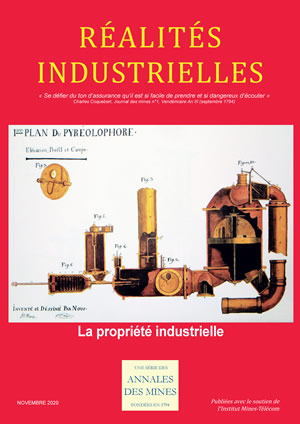| |

|
|
 Novembre 2020 - La propriété industrielle Novembre 2020 - La propriété industrielle
De la loi de 1791 à la dématérialisation, 230 ans d’innovations en France
Par Steeve GALLIZIA
INPI
et
Serge CHAMBAUD
Ancien directeur du Musée des Arts et Métiers
De l’Antiquité jusqu’à la loi PACTE, en traversant les révolutions ‒ française, puis industrielle ‒, la protection de la propriété industrielle n’a cessé de se renforcer au cours du XIXe siècle, s’appuyant sur un cadre législatif national et désormais international avec la convention d’Union de Paris. Les conditions de l’obtention et de l’exploitation des trois titres de propriété industrielle que sont les brevets, les marques, et les dessins et modèles sont désormais fixées. Notamment, la recherche d’antériorité permettant de prouver la nouveauté de l’invention, l’originalité du dessin ou modèle, ou encore la liberté d’exploitation d’une marque, fait apparaître des besoins nouveaux en matière de recherche documentaire, qui amèneront l’INPI à mettre très tôt en place les conditions d’accès à l’information sous sa forme numérique. Puis suivront la dématérialisation des procédures et la diffusion des bases en open data, suivant une stratégie résolument tournée vers la donnée.
 Télécharger gratuitement l'article Télécharger gratuitement l'article
 Retour au sommaire Retour au sommaire
 November 2020 -Industrial property November 2020 -Industrial property
From a 1791 act to dematerialization, 230 years of innovation in France
Steeve Gallizia,
INPI,
and
Serge Chambaud,
former director of the Musée des Arts et Métiers
From Ancient history to the PACTE Act in France, not to mention the French and then industrial revolutions, the protection of industrial property rights has been constantly reinforced, especially during the 19th century. The grounds for doing this have been laid by French legislation and the international framework set up under the Paris Convention in 1883, which established a Union for the Protection of Industrial Property. The conditions have been defined for obtaining and using three sorts of industrial property rights: patents, trademarks, and designs. Patent prior art searches to prove the novelty of an invention, the originality of a design, or the right to use a trademark have brought to light new needs in information retrieval. The French Patent and Trademark Office (INPI) has fostered the conditions for finding information in electronic formats. More recently, procedures have been dematerialized, and information has been made available in open data bases, the reflection of a strategy decidedly turned toward data.
 Retour au sommaire Retour au sommaire
|
|




